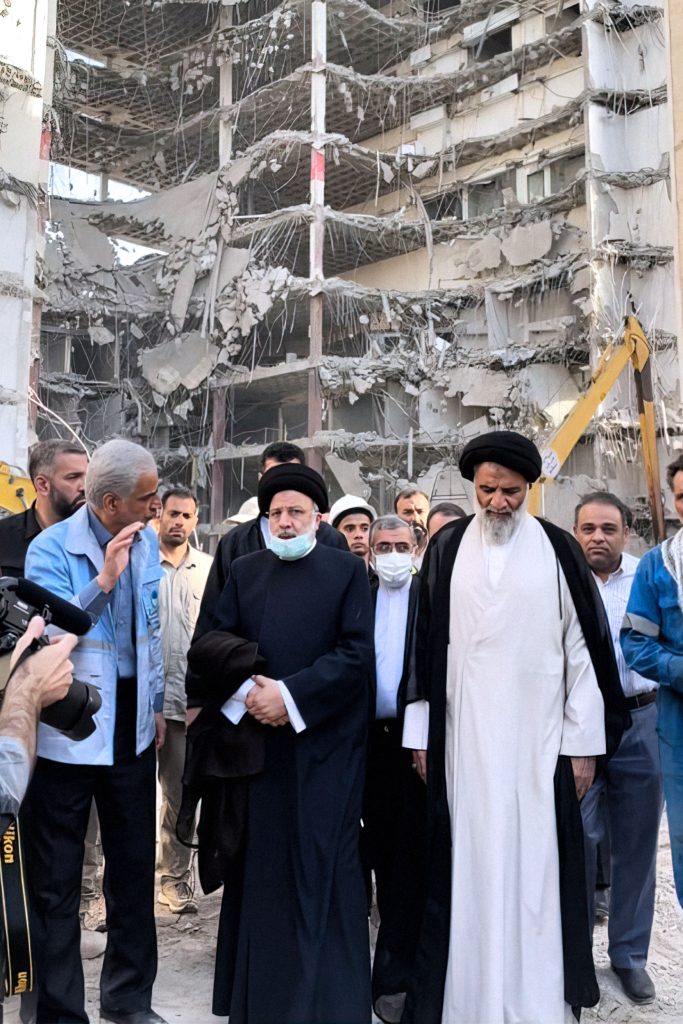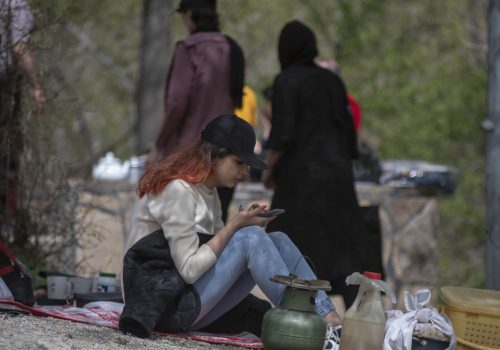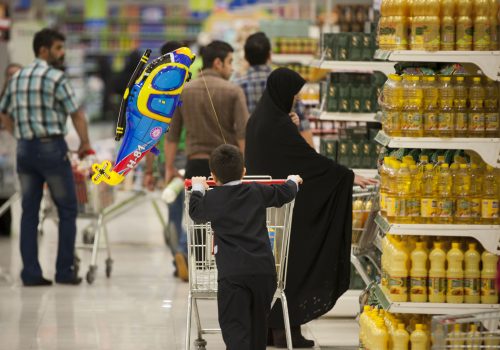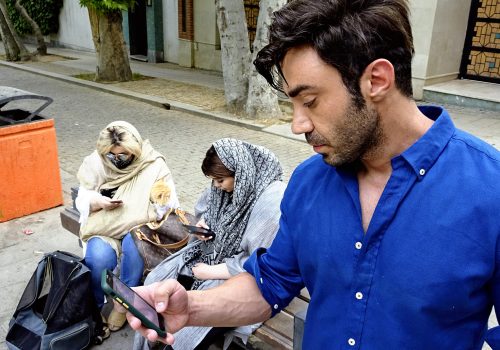‘From Cinema Rex to Metropol,’ Iranians have had enough
Clad in black and eyes blazing with rage and grief, Iranians beat a tune on dozens of drums—the same one they have played for generations in southern Iran to plead for the sea to return their dead sailors.
As the night is filled with the tune of drums and metallic clamor of cymbals, the people of Abadan, in southwestern Khuzestan province, mourn lives lost to corruption under the debris of a collapsed tower, the Metropol.
On May 23, the ten-story commercial tower came crashing down on people’s heads in Abadan. As of June 6, forty-one bodies were pulled from the rubble, including at least five children.
With each body recovered from the ruins, public anger crescendoed, leading to ongoing street protests in multiple areas in Khuzestan. The state responded with brutal force and partial Internet shutdowns—the same tactics it used earlier in May amid protests over state-mandated food price hikes.
People, top officials, and even state media have blamed the tragedy on negligence as well as “widespread” and “structural” corruption.
The state has tried to paint the corruption as limited to urban and provincial levels, saying that, so far, thirteen people have been arrested in relation to the building collapse, including current and former mayors of the city.
However, a Germany-based investigative journalist, Saeed Hafezi, and the Persian service of The Independent have implicated top officials, including First Vice President Mohammad Mokhber and the Secretary of the powerful Supreme National Security Council, Ali Shamkhani—the latter was appointed to the post by Supreme Leader Ayatollah Ali Khamenei.
Furthermore, what has been seen as an inefficient and slow state response to the disaster combined with contradictory news about the fate of the building’s owner, Hossein Abdolbaqi, have stoked public anger.
Where is Abdolbaqi?
Videos from the scene of the disaster show disheveled young men breaking down in tears and saying that “no one cares about us,” complaining that ordinary people are digging among the rubble in an attempt to find their loved ones while officials only visit the site for photo ops.
Initially, after the collapse, multiple state-linked news agencies—including the government-run Islamic Republic News Agency (IRNA) and Tasnim and Fars news agencies, which are linked to the Islamic Revolutionary Guards Corps (IRGC)—reported that Abdolbaqi had been “arrested.” But, later, officials announced that he had actually died in the collapse, with Fars News describing the earlier reporting as “erroneous.”
The owner, who was widely referred to as “Haj Hossein,” a religious title of honor, had extensive ties to top officials and played a role in local and national elections.
Pointing to Abdolbaqi’s state ties, many people, including journalist Hafezi, who covers Khuzestan, have alleged that the news about his death are “lies.” A video published by protest documentation network 1500Tasvir from Abadan shows people chanting, “It’s a lie, it’s a lie! Abdolbaqi is not dead!”
“Don’t shoot! Don’t shoot!”
As bodies were recovered from the wreckage of the Metropol, gatherings were held in solidarity with the people of Abadan in multiple cities, including Bushehr, Tehran, Ramhormoz, Baghmalek, Yazd, Semnan, Kermanshah, and Shiraz.
Two days after the incident, on May 25, authorities deployed riot police to prevent and disperse gatherings as they turned into protests against the clerical establishment. Videos from protests on May 31 show people chanting “Death to Khamenei” in Tehran and “Death to the dictator” in Bushehr.
While social media posts show children attending the gatherings, videos shared by journalists and activists indicate that riot police have used brute force against people, including batons, tear gas, water cannons, and even live rounds.
A video from May 28 protests in Abadan also went viral on the same day, in which multiple shots are heard in the background, with a man screaming: “Don’t shoot! Don’t shoot!”
As the tragedy shook the nation, the Islamic Republic once again showed that it was divorced from people’s realities.
It took the Supreme Leader three days to extend “condolences” to the families of the victims on May 26 while thanking the government for its “efforts” toward handling the issue. The government of hardline President Ebrahim Raisi also dragged its feet for six days before announcing a national day of mourning. Amid public criticism, Raisi visited the Metropol collapse site in an unannounced trip to Abadan on June 3—eleven days after the disaster.

On the same day, a state-organized jubilant gathering was held at Tehran Azadi Stadium, where thousands of children pledged allegiance to the Supreme Leader singing a religious song seen as the establishment’s effort to indoctrinate kids.
The elated mood of the state-organized gathering and top officials’ disregard for the tragedy enraged the grieving people of Abadan and they took to the streets on the same night chanting: “Abadan is bleeding and they are holding celebrations in Tehran!”
Search for meaning
Iran, over the past years, has been hit by wave after wave of tragedy, from the brutal killing of hundreds of protesters in November 2019 to the downing of the Ukraine passenger flight PS752 by two IRGC missiles in January 2020, and now the Metropol’s collapse.
In the face of these senseless tragedies, many Iranians have been shuffling through history books in search of meaning.
When the IRGC shot down PS752, killing all 176 onboard, and rejecting any wrongdoing for several days, people compared the tragedy with the Chernobyl disaster and the Soviet Union’s denials.
Now, mourning lives lost in the Metropol collapse, many are seeing echoes of a tragedy that struck Abadan in 1978, when Cinema Rex was targeted in an apparently politically-motivated arson attack that killed hundreds, ignited unrest across Iran’s oil-rich provinces, and contributed to the lead up to the Islamic Revolution almost a year later, which toppled Shah Mohammad Reza Pahlavi.
Drawing upon history, protesters in Abadan chanted on May 27: “From Cinema Rex to Metropol, patience is enough!”
As the frequency of protests increase in Iran and people often target top echelons of power, including the Supreme Leader, there is one thing in common between the historical analogies: they all predict the collapse of the Islamic Republic.
Khosro Sayeh Isfahani is an advocate, journalist, and Internet researcher with years of experience working in Iran, including work related to the LGBTQI community.
Further reading
Tue, Apr 12, 2022
The Internet ‘Protection Bill’ will hurt all Iranians, but the queer community will have the most to lose
IranSource By
International human rights organizations and the United Nations are saying a lot about the repressive “Protection Bill.” However, not much light has been shed on one of the most marginalized groups that will suffer the most: Iran’s LGBTQI community.
Thu, May 12, 2022
The Ebrahim Raisi government just jacked up food prices. Iranians are understandably angry.
IranSource By
The government of hardline President Ebrahim Raisi—who has been in office for less than a year—has opted to introduce coupons for almost everything from bread to Internet.
Tue, May 24, 2022
The Biden administration needs to do more on Iran. Here’s why.
IranSource By Holly Dagres
Having a consistent, actionable approach to Iran is what the Biden administration needs to stay on course with its human rights agenda. Now is a good place to start.
Image: Mother of one of the victims who lost his life in the Metropol collapse is seen at the site of the disaster. (IRNA)


